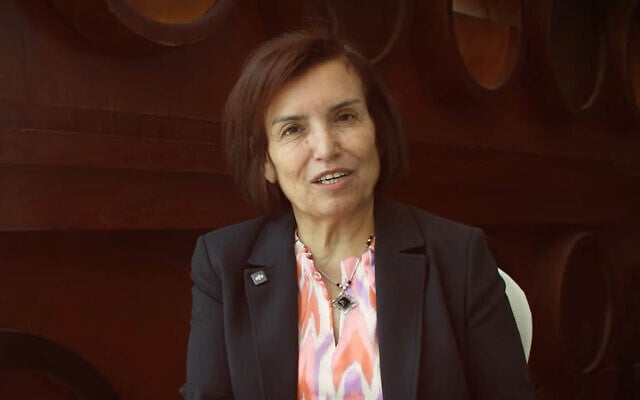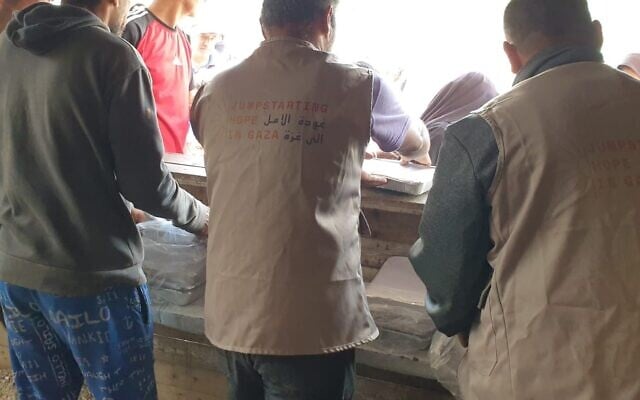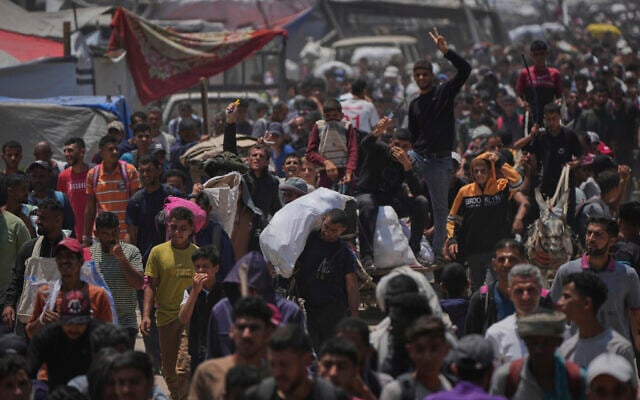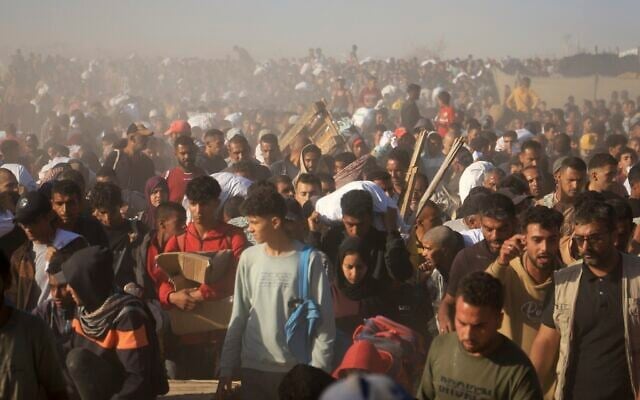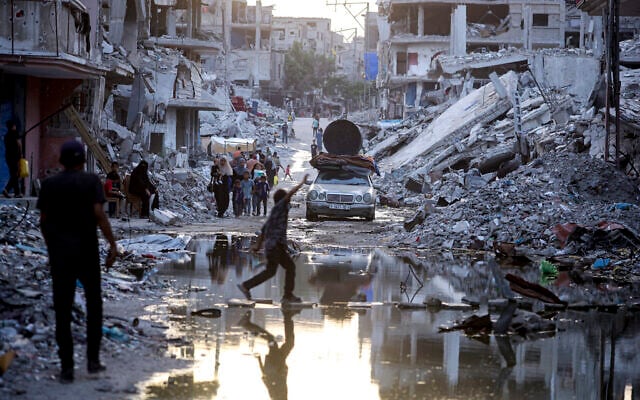


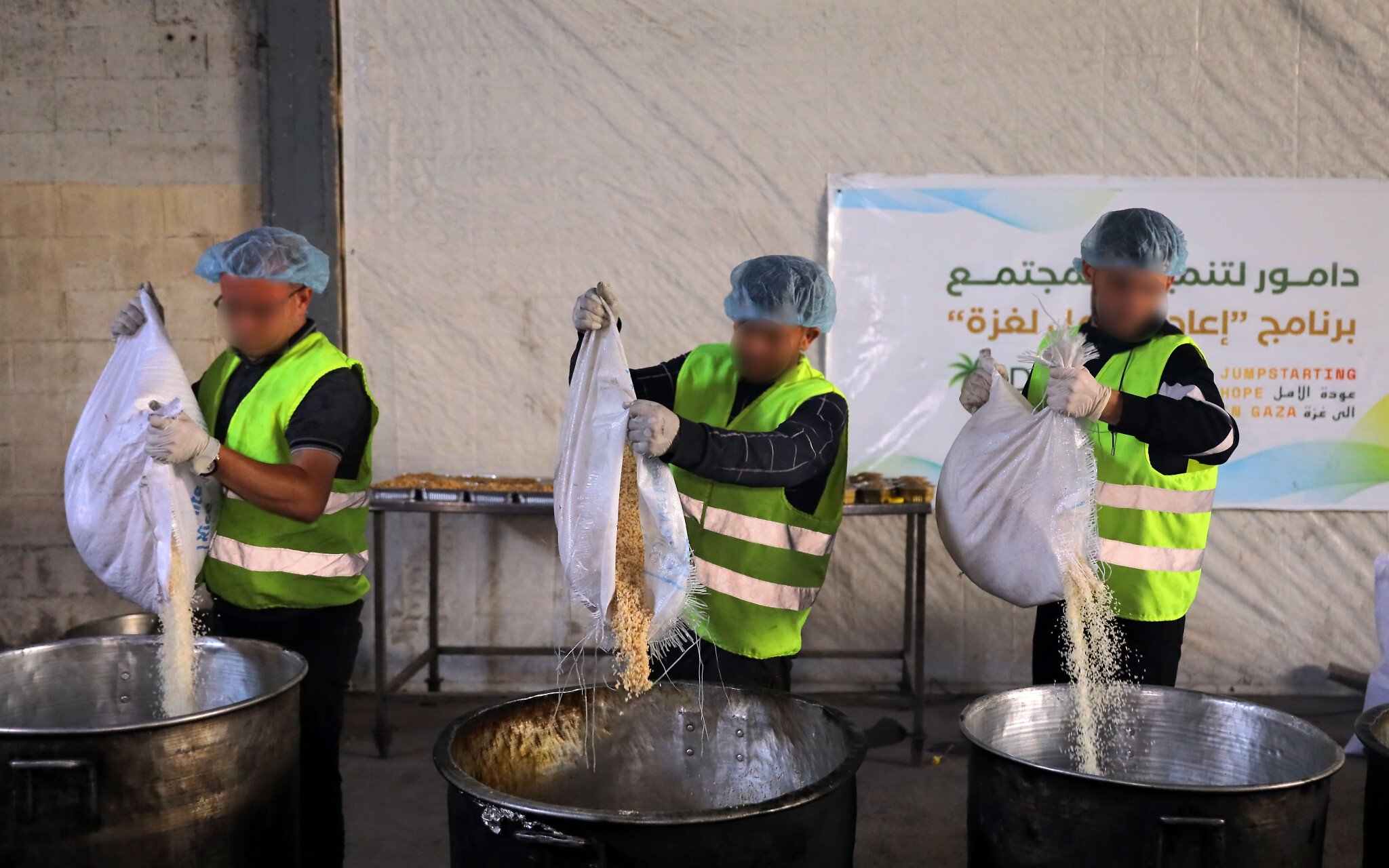
An Israeli and a Palestinian nonprofit have been partnering to purchase food for tens of thousands of Gazans and have already distributed 60,000 portions of cooked food prepared by an Arab company, which had sufficient rice and chickpeas in storage in Gaza.
According to Tahani Abu Daqqa, a board member of the Palestinian organization Damour for Community Development, who is responsible for Gaza, the food cost $90,000 ($1.50 per portion), which she said was high.
“This week, the company told me the prices have doubled,” she told The Times of Israel last week.
Abu Daqqa, who left Gaza for Cairo in April 2024 and has been unable to return, said she did not know where the food had come from, or why and for how long it had been stored. Preferring not to give the supplier company’s name, she added that she feared asking too many questions could scupper the deal.
Abu Daqqa oversees Damour’s Mesk and Leyan displaced persons camp in Mawasi, southern Gaza, where numbers rise and fall depending on where the IDF is operating. Numbers there have recently risen to an estimated 1,000 families.
“We’ve used the money we had,” she said. “[When we get more], we will buy either from the market or from suppliers who have stock. We can’t afford double the price.”
Damour for Community has long partnered with the southern Israel-based Arava Institute for Environmental Studies on solar energy and off-grid solutions for clean water and sewage recycling in Gaza and the West Bank.
In the year to April, against the backdrop of widespread destruction to infrastructure in the enclave as a result of the ongoing war, the partnership focused on a joint project, Jumpstarting Hope in Gaza, to address these needs in the Strip.
Their involvement in food aid only started after Israel imposed a humanitarian aid blockade in March in an attempt to pressure Hamas into releasing the remaining hostages abducted on October 7, 2023. On that day, the terror organization invaded southern Israel, slaughtered 1,200 people, most of them civilians, and kidnapped 251 to the Strip.
Barak Talmor, responsible for managing Jumpstarting Hope at the Arava Institute, said Sunday, “We are monitoring the situation to figure out what our next intervention will be. We don’t have unlimited resources. The options include food, toilets (in addition to 70 already installed with $20,000 from the institute), and more trucks of drinking water. We are also examining the possibility of building a desalination system from materials in Gaza or building a pipeline from a desalination unit nearby.”
During the Muslim month of Ramadan and Eid al-Fitr, Damour bought fresh vegetables from local farmers for some 10,000 families living in tents or in the open in and around the Mesk and Leyan camp. The Arava Institute contributed $20,000 to feed 600 families, Talmor said.
By April, food supplies in the whole enclave were running low, and the prices of what remained exceeded the purchasing power of ordinary Gazans. It was at this point that Damour approached the Arava Institute for urgent financial help, according to the Talmor.
The food aid was financed by some of the NIS 673,000 ($189,000) raised so far from Israelis as part of an ongoing monthlong NIS 750,000 ($215,000) fundraising campaign by peace organizations.
It was also supported by SmartAID and Movement on the Ground.
Abu Daqqa, a Gazan who lost 14 close relatives in March from a bomb dropped on their building, said that with the lack of fuel and electricity, people were eating cold food wherever they could find it.
The hot meals the organization handed out were cooked by the company that supplied the raw materials in kitchens in the Strip’s south and north, she added.
Dozens of Damour volunteers distributed the food in and around the Mesk and Leyan camp, the Zomi camp nearby (currently run by another organization), and in Jabalia, Beit Hanoun, and Gaza City in the Strip’s north, she said.
With fluctuating aid policies, Israel’s government has been caught between coalition pressure to use humanitarian aid to force Hamas to release the hostages and international warnings that Gazan civilians must not be allowed to starve.
Israel imposed a blockade on the Strip from March, then lifted it on May 19. Together with the US, it is now backing the controversial Gaza Humanitarian Foundation set up to wrest control over aid from Hamas and distribute it directly to the population.
International organizations, including the UN, from which Hamas reportedly looted aid in the past, are refusing to cooperate, while continuing to send their aid into the Strip, according to Israel’s Coordinator of Government Activities in the Territories. Since May 19, when Israel resumed aid, over 1,350 trucks have entered the Strip, COGAT said.
Reports that amid the throngs of hungry Gazans pushing forward to get aid, dozens have been shot and killed are challenging to verify during what Times of Israel founder and editor David Horovitz recently described as the fog of war.
With groundwater polluted by seawater and pumps idle because there is no electricity, most Gazans pay for (or receive donations of) drinking water from large trucks.
Abu Daqqa said that the water supply at the Mesk and Leyan camp had just run out, and an urgent appeal to donors had been issued.
When brackish water was available, it was used for cooking and showering, Abu Daqqa explained.
“Yesterday, there was a row in the shelter as it was very hot and people wanted to shower, but there wasn’t enough water for everyone. Some haven’t showered for a week or more. We tried to get them to establish a rotation,” she said.
Around 100 toilets (including the 70 donated by the Arava Institute) drain into pits in the camp, with new pits having to be dug daily, according to Abu Daqqa. The ground around the camp was filling up with subterranean sewage, she went on, while pools of human waste on the streets elsewhere in the Strip were causing illness and drawing hordes of mosquitoes.
Arava Institute executive director Tareq Abu Hamed said Gaza’s water, sewage, and waste systems had collapsed entirely. He said that people had to wait hours to use a toilet, especially women, and that according to the UN, hundreds of thousands of Gazans were suffering from Hepatitis A — a virus linked to contact with contaminated feces.
David Lehrer, head of the institute’s Center for Applied Environmental Diplomacy, said that over the past 18 months, the institute has raised approximately $2.5 million in funds and in-kind donations for Jumpstarting Hope in Gaza, which Damour was to implement on the ground.
So far, however, the Coordinator of Government Activities in the Territories (COGAT) has refused to allow the machinery into the Gaza Strip, apparently for fear it could be used for other purposes by terror organizations.
Lehrer said he hoped the food distribution system would improve and that Jumpstarting Hope could help Gazans stabilize the rest of their lives by providing solar energy for lighting, heating, and cooling, as well as clean drinking water and sanitation to prevent disease from spreading through Gaza and eventually into Israel.
By press time, COGAT had not responded to a query regarding permission to bring the equipment into the Strip.

